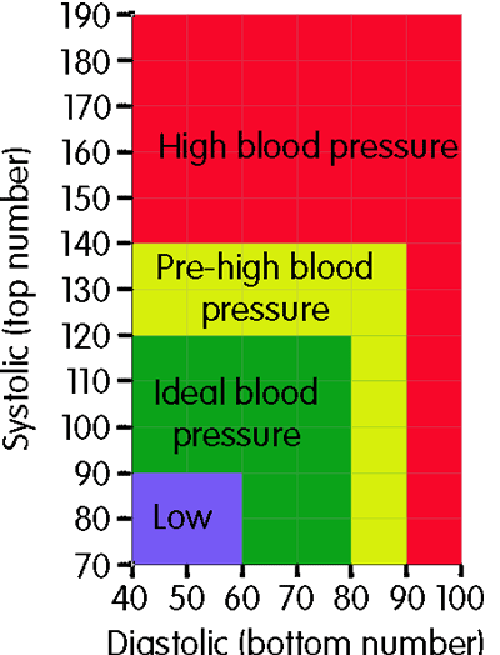When Checking Blood Pressure What Is the Bottom Number
Find out how to understand blood pressure readings and use our blood pressure chart to see how healthy your blood pressure is.
What does a blood pressure reading look like?
When you have your blood pressure measured, you will be given two numbers, a top number and a bottom number.
- Systolic blood pressure. This is the first, or top, number. This is the highest level your blood pressure reaches when your heart beats, forcing blood around your body.
- Diastolic blood pressure. The second number, or bottom number, is the lowest level your blood pressure reaches as your heart relaxes between beats.
Blood pressure is measured in millimetres of mercury (mmHg). If the first number is 120 and the second number is 80, this would be written as 120/80mmHg, and you'd call it '120 over 80'.
This video explains more about systolic and diastolic blood pressure.
The blood pressure chart
Once you know your numbers, you can use the blood pressure chart to see what they mean and if your blood pressure is in the healthy range. The chart is suitable for adults of any age, as the cut-off point for diagnosing high blood pressure doesn't change with age.

How to use the blood pressure chart
Simply find your top number (systolic) on the left side of the chart and your bottom number (diastolic) on the bottom. Where the two lines meet is your blood pressure.
Download the chart. Blood pressure chart for adults - PDF [PDF 121KB]

Get ready for Christmas early with our range of beautiful cards, wrapping paper and gifts including personalised notebooks. Whether you're looking for something traditional or modern, we're sure you will find something you love. Shop now at Care Cards who will post the items on our behalf. 25% goes to fund our life-saving work.
What do the readings mean?
As a general guide:
• 140/90mmHg or over – you may have high blood pressure
Most doctors use 140/90mmHg as the cut off for point for diagnosing high blood pressure (hypertension). This is the point where your risk of serious health problems goes up. They might prescribe medications and advise you to make changes to your lifestyle to bring your blood pressure down.
• 120/80mmHg up to 140/90mmHg – pre-high blood pressure
Also called high-normal blood pressure. This is not high blood pressure, but it is a little higher than it should be and means you could go on to develop high blood pressure. See how you can make healthy changes to your lifestyle to lower it.
• 90/60mmHg up to 120/80mmHg – ideal blood pressure
Also called normal blood pressure. Your blood pressure reading is healthy. At this level you have a much lower risk of heart disease and stroke. Following a healthy lifestyle will help you to keep it in the healthy range.
• 90/60mmHg or lower – you may have low blood pressure
Low blood pressure usually isn't a problem, but it can sometimes make you feel faint or dizzy or could be a sign of another health problem.
The video below explains how your blood pressure numbers are linked to the risk of stroke and other disease.
Diagnosing high or low blood pressure
Only one of your numbers needs to be higher than it should be to be diagnosed with high blood pressure, and only one needs to be lower than it should be to be diagnosed with low blood pressure.
So if your top number is over 140 or the bottom number is over 90, you may be diagnosed with high blood pressure, regardless of the other number. If your top number is under 90 or your bottom number is under 60, you may be diagnosed with low blood pressure. Use the chart to see where your numbers sit.
If your top number (systolic pressure) is consistently higher than 140mmHg, but the bottom number is healthy - this is known as Isolated Systolic Hypertension. If the bottom number (diastolic pressure) is consistently higher than 90mmHg but the top number is healthy - this is known as Isolated Diastolic Hypertension.
Making sure your readings aren't a one-off
A single high reading doesn't necessarily mean you have high blood pressure, as many things can affect your blood pressure throughout the day, such as the temperature, when you last ate, and if you're feeling stressed.
Your doctor or nurse will probably want to measure your blood pressure a number of times over a few weeks to make sure the reading wasn't just a one off and that your blood pressure stays high over time.
Read about how high blood pressure is diagnosed, getting a blood pressure check, the further tests you might have if you have a high blood pressure reading, and what it means if you're diagnosed with high blood pressure.
Read more
Find out why systolic blood pressure is the most important when it comes to keeping an eye on your numbers.
When Checking Blood Pressure What Is the Bottom Number
Source: https://www.bloodpressureuk.org/your-blood-pressure/understanding-your-blood-pressure/what-do-the-numbers-mean/
0 Response to "When Checking Blood Pressure What Is the Bottom Number"
Post a Comment